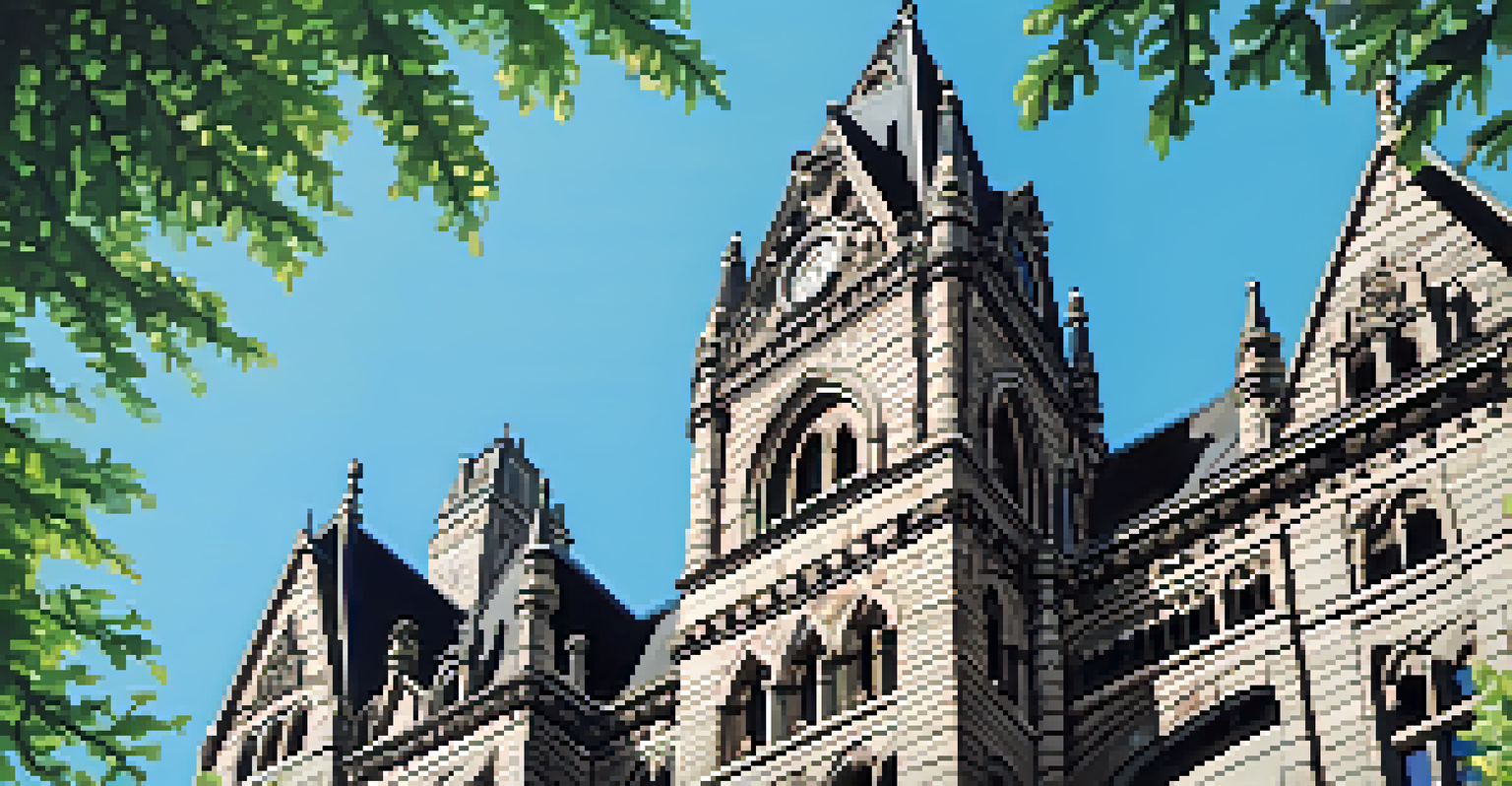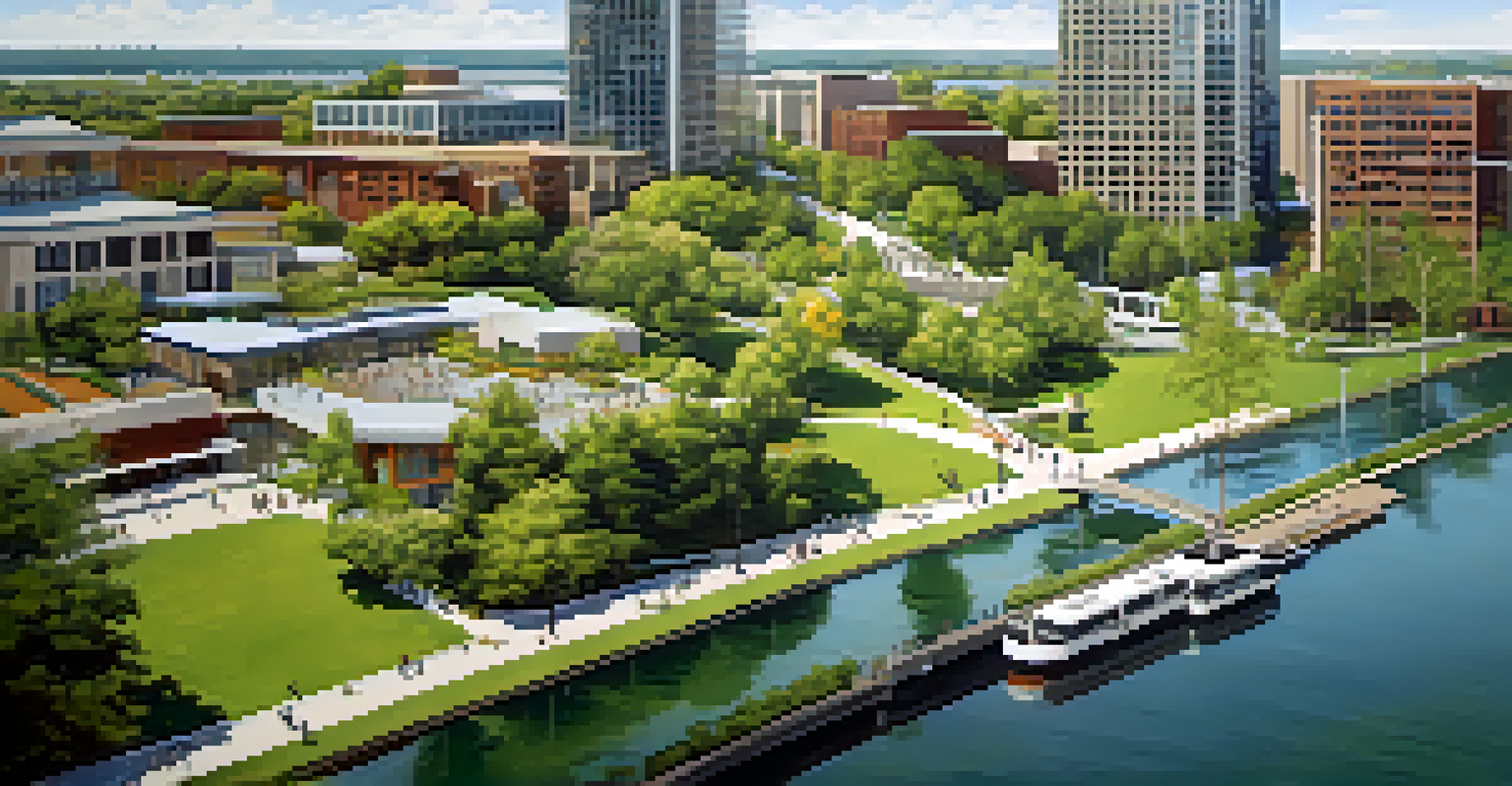Modern Architecture vs. Historical Styles in Pittsburgh

The Architectural Landscape of Pittsburgh
Pittsburgh's architectural scene is a vibrant tapestry woven from various styles, each telling a unique story. From the steel bridges to the iconic skyscrapers, the city embodies a blend of modern innovation and historical charm. This mix creates an environment where the past and present coexist harmoniously, making Pittsburgh a fascinating place for architecture enthusiasts.
Architecture is the art of how to waste space.
When wandering through the city, one can easily spot the stark contrasts between sleek glass buildings and the ornate facades of historical structures. This juxtaposition reflects the city's evolution from an industrial hub to a modern metropolis. Each architectural style contributes to the city's identity, showcasing its rich history and forward-thinking spirit.
In this article, we will explore the key characteristics of both modern architecture and historical styles in Pittsburgh. By comparing these two distinct yet complementary elements, we aim to highlight how they shape the city's character and appeal, making it a unique destination for both locals and visitors alike.
Understanding Modern Architecture in Pittsburgh
Modern architecture in Pittsburgh is defined by its innovative use of materials, minimalist designs, and functional spaces. Buildings like the PNC Park and the David L. Lawrence Convention Center exemplify this style through their sleek lines and open layouts. These structures not only serve their purposes but also enhance the city's skyline with their contemporary aesthetics.

A hallmark of modern architecture is its emphasis on sustainability and environmental consciousness. Many new buildings in Pittsburgh incorporate green technologies, such as energy-efficient systems and sustainable materials, to reduce their environmental impact. This approach aligns with the city’s commitment to becoming a greener, more sustainable urban environment.
Pittsburgh's Architectural Diversity
The city's architecture showcases a vibrant mix of modern and historical styles, reflecting its rich industrial past and innovative future.
Moreover, modern architecture often seeks to create a sense of community. Spaces like the North Shore Riverfront Park encourage social interaction and outdoor activities, blending urban living with nature. This focus on community and sustainability reflects a broader trend in modern architecture that resonates deeply with Pittsburgh's evolving identity.
Historical Architectural Styles in Pittsburgh
Pittsburgh's historical architecture is a testament to its rich industrial past and cultural heritage. Styles such as Romanesque, Gothic Revival, and Beaux-Arts are prominently featured in iconic buildings like the Allegheny County Courthouse and the Carnegie Library. These structures showcase intricate details, grand façades, and a sense of permanence that speaks to the city’s history.
The best way to predict the future is to design it.
The preservation of historical architecture plays a vital role in maintaining Pittsburgh's identity. Efforts to restore and repurpose these buildings ensure that their stories continue to be told, providing a tangible connection to the past. For instance, the transformation of the old Nabisco factory into the contemporary Bakery Square exemplifies how historical structures can adapt to modern needs while preserving their character.
Furthermore, historical architecture often serves as a backdrop for cultural events and community gatherings. These buildings provide spaces for art galleries, theaters, and museums, enriching the urban experience. By celebrating these historical styles, Pittsburgh honors its heritage while embracing the future.
Key Differences Between Modern and Historical Styles
One of the most significant differences between modern and historical architecture lies in their design philosophies. Modern architecture prioritizes simplicity, functionality, and innovative materials, while historical styles are characterized by elaborate details, ornamentation, and traditional craftsmanship. This contrast reflects the changing values and priorities of different eras.
Another distinction is the relationship between buildings and their surroundings. Modern architecture often embraces open spaces and integrates natural elements, creating a seamless connection between indoor and outdoor environments. In contrast, historical buildings are typically designed to stand as individual statements, often with limited interaction with their surroundings.
Community Shapes Architectural Growth
Local involvement is crucial in preserving historical buildings while ensuring new developments meet the needs and values of residents.
These differences also influence how people experience and interact with each style. Modern buildings tend to foster a sense of community through shared spaces and amenities, while historical structures often evoke a sense of nostalgia and admiration for craftsmanship. Understanding these distinctions enriches our appreciation for Pittsburgh's diverse architectural landscape.
The Influence of Pittsburgh's Industrial Past
Pittsburgh's industrial past significantly shaped its architectural landscape, influencing both modern and historical styles. The city’s rapid growth during the steel boom led to the construction of numerous factories and warehouses, many of which have since been repurposed for modern use. This transformation showcases the resilience and adaptability of Pittsburgh's architecture.
Many historical buildings were designed to serve specific industrial functions, with robust structures that reflect the city’s manufacturing heritage. For example, the Strip District's old warehouses have become trendy shops and restaurants, blending the old with the new. This fusion of historical and modern elements creates a unique urban environment that honors its roots.
Additionally, the industrial heritage continues to inspire contemporary architects in their designs. Many modern buildings incorporate elements reminiscent of the industrial age, such as exposed beams and raw materials, paying homage to Pittsburgh's storied past. This ongoing dialogue between the past and present enriches the architectural narrative of the city.
The Role of Community in Architectural Development
Community involvement plays a crucial role in the evolution of Pittsburgh's architectural landscape. Local residents and organizations often advocate for the preservation of historical buildings, ensuring that the city's heritage is honored amidst new developments. This grassroots involvement fosters a sense of ownership and pride in the community.
Moreover, modern architectural projects frequently incorporate input from the community to create spaces that reflect local needs and values. For instance, initiatives like the Hill District revitalization focus on engaging residents in the planning process, ensuring that new developments serve the community's interests. This collaborative approach strengthens the bond between architecture and the people it serves.
Embracing Sustainable Innovations
Pittsburgh's future architecture focuses on sustainability and adaptive reuse, balancing respect for history with modern urban needs.
Ultimately, the interplay between community and architecture enriches Pittsburgh's urban fabric. By valuing both modern and historical styles, the city creates a dynamic environment where diverse voices are heard and celebrated. This commitment to community involvement not only preserves Pittsburgh's past but also shapes its future.
Embracing the Future of Architecture in Pittsburgh
As Pittsburgh continues to evolve, the future of its architecture lies in the balance between honoring its historical roots and embracing modern innovations. The city’s commitment to sustainable development and smart city initiatives reflects a forward-thinking approach that prioritizes livability and environmental responsibility. This vision promises to enhance the urban experience for generations to come.
Emerging architectural trends, such as adaptive reuse and mixed-use developments, are becoming increasingly popular in Pittsburgh. These approaches not only preserve historical structures but also breathe new life into them, creating vibrant spaces that foster community and economic growth. The transformation of old buildings into modern hubs exemplifies how the city is creatively navigating its architectural future.

Ultimately, the journey of Pittsburgh’s architecture is one of resilience and innovation. By honoring its past while looking to the future, Pittsburgh stands as a testament to the power of architecture as a reflection of culture, community, and continuity. The city invites everyone to explore its diverse architectural landscape and witness the stories that unfold within it.